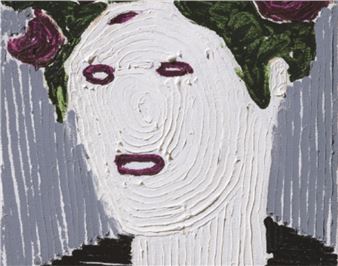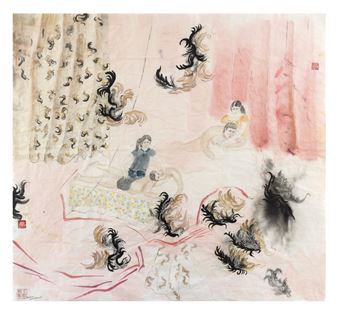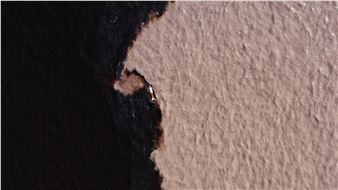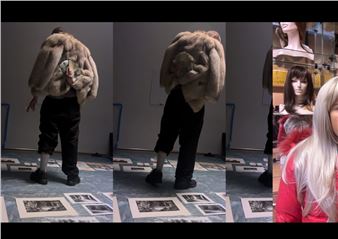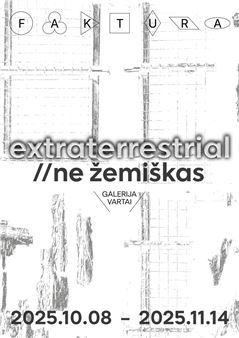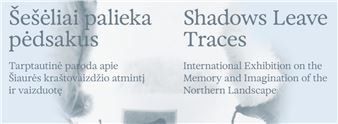Rutene Merk: Promises
How are new technologies changing bodies, their representation and the very concept of corporeality? What are the capabilities of the old medium of painting to reflect both the desires of our time and the promises of technology? Employing the classical genres of portrait and still life, in her paintings RЕ«tД— Merk captures the conditions of the contemporary world, characterised by the shifting boundaries between the material and the virtual, the natural and the artificial, and the concrete and the abstract.вҖҜ
Although MerkвҖҷs portraits flirt with the history of painting, they are undoubtedly a testament to the era of tracksuit bottoms and business casual suits rather than vestments and regalia. Representative of todayвҖҷs pop culture, fashion and the specific habits of the millennials, they stem from the artistвҖҷs impressions, fragmented memories, and a purposeful archaeology of digital culture. Seamless at first glance, these portraits are made up of a multitude of fragments of different bodies accumulated in the artistвҖҷs personal archive of digital images. AriyaвҖҷs face is borrowed from the character in the popular TV series Game of Thrones, while the rest of the body is anonymous; JomantД— is constructed from various image sources in an attempt to imagine the typical employee of a successful art gallery, and ends up being named after the artistвҖҷs best friend in school. Meanwhile, Yssa is a loosely interpreted portrait of a Belarusian DJ based in Berlin. Hovering in abstract backgrounds, these figures are characterised by weightlessness. They attest to the artistвҖҷs effort to вҖҳembody disembodimentвҖҷ, the effect suggestive of the constantly moving boundaries of the subject when faced with a perpetually mediated reality. вҖҜ
Several centuries ago, still life painters composed images of hunting trophies, ripe fruit and flower bouquets, as they sought to convey images of mortality, the cycle of life, and the wealth of the middle-class. In MerkвҖҷs still lifes, we find consumer products that have become attributes of an aestheticized modern lifestyle and economic prosperity. The latte motif, enlarged to the extent it approaches abstraction, aspires to serve as an allegory of global economic networks and the anxious culture of productivity. The artistвҖҷs paintings blur the distinction between the natural and the synthetic. Imagery such as blue orchids that do not exist in nature, or perfectly identical artificially bred fruit signify engineered interventions into the most intimate spheres of nature.вҖҜ
Two similarly composed portraits of Aki Ross, one of the first computer-generated film protagonists, demonstrate the development of the artistвҖҷs style. In Spirits Within (2018), unlike the expressive, gestural Greta (2015), the colours, visual effects, figure modelling, and composition are reminiscent of images generated by digital image editing software intended for on-screen viewing, such as in video games and 3D animation. The dissolving, blurry, out-of-focus, strangely uncanny backgrounds also appear as if intended for the eyes of a machine rather than a human being. The exhibition invites us to think not only about what we see but also how we see under the light of on-screen suns.вҖҜ
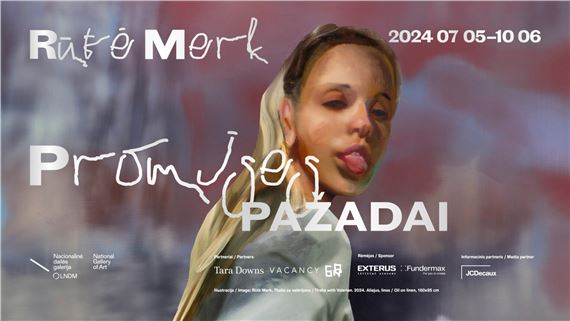
Recommended for you
How are new technologies changing bodies, their representation and the very concept of corporeality? What are the capabilities of the old medium of painting to reflect both the desires of our time and the promises of technology? Employing the classical genres of portrait and still life, in her paintings RЕ«tД— Merk captures the conditions of the contemporary world, characterised by the shifting boundaries between the material and the virtual, the natural and the artificial, and the concrete and the abstract.вҖҜ
Although MerkвҖҷs portraits flirt with the history of painting, they are undoubtedly a testament to the era of tracksuit bottoms and business casual suits rather than vestments and regalia. Representative of todayвҖҷs pop culture, fashion and the specific habits of the millennials, they stem from the artistвҖҷs impressions, fragmented memories, and a purposeful archaeology of digital culture. Seamless at first glance, these portraits are made up of a multitude of fragments of different bodies accumulated in the artistвҖҷs personal archive of digital images. AriyaвҖҷs face is borrowed from the character in the popular TV series Game of Thrones, while the rest of the body is anonymous; JomantД— is constructed from various image sources in an attempt to imagine the typical employee of a successful art gallery, and ends up being named after the artistвҖҷs best friend in school. Meanwhile, Yssa is a loosely interpreted portrait of a Belarusian DJ based in Berlin. Hovering in abstract backgrounds, these figures are characterised by weightlessness. They attest to the artistвҖҷs effort to вҖҳembody disembodimentвҖҷ, the effect suggestive of the constantly moving boundaries of the subject when faced with a perpetually mediated reality. вҖҜ
Several centuries ago, still life painters composed images of hunting trophies, ripe fruit and flower bouquets, as they sought to convey images of mortality, the cycle of life, and the wealth of the middle-class. In MerkвҖҷs still lifes, we find consumer products that have become attributes of an aestheticized modern lifestyle and economic prosperity. The latte motif, enlarged to the extent it approaches abstraction, aspires to serve as an allegory of global economic networks and the anxious culture of productivity. The artistвҖҷs paintings blur the distinction between the natural and the synthetic. Imagery such as blue orchids that do not exist in nature, or perfectly identical artificially bred fruit signify engineered interventions into the most intimate spheres of nature.вҖҜ
Two similarly composed portraits of Aki Ross, one of the first computer-generated film protagonists, demonstrate the development of the artistвҖҷs style. In Spirits Within (2018), unlike the expressive, gestural Greta (2015), the colours, visual effects, figure modelling, and composition are reminiscent of images generated by digital image editing software intended for on-screen viewing, such as in video games and 3D animation. The dissolving, blurry, out-of-focus, strangely uncanny backgrounds also appear as if intended for the eyes of a machine rather than a human being. The exhibition invites us to think not only about what we see but also how we see under the light of on-screen suns.вҖҜ

 ARTISTS
ARTISTS







